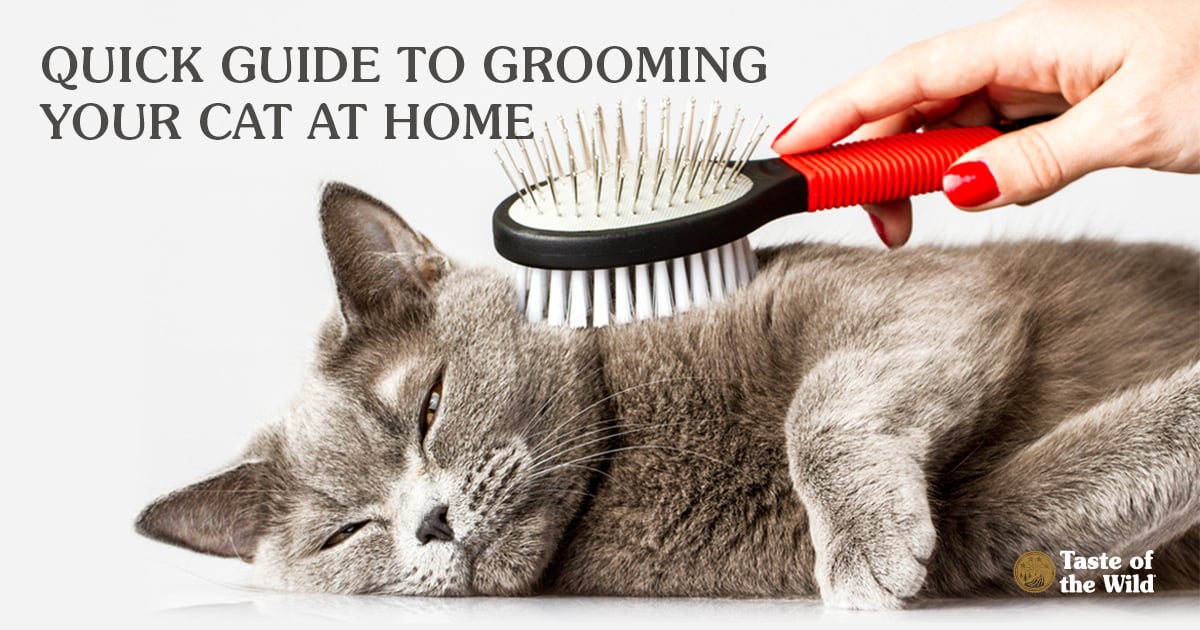
After eating and napping, it seems cats’ third favorite hobby is grooming. But even the tidiest of kitties could use some help staying neat and clean — beyond the occasional brushing, of course. Check out these tips to keep your cat healthy and happy (by cat standards, at least).
BRUSH IT OUT
The first grooming chore that comes to mind is, of course, brushing. Not only does brushing out the coat remove any pesky tangles, it also removes dead hair and dirt and spreads healthy oils throughout their coat. Depending on your kitty’s hair, they may need to be brushed weekly or even daily.
Regularly brushing their hair also reduces the chances you’ll find them hacking up those dreaded hairballs. Long-haired cats are more likely to develop hairballs, but it can happen to any kitty with an excess of loose hair on their body. Daily brushing can help control how much dead hair your kitty swallows while grooming themselves.
TIME FOR A KITTY PEDI
Many people don’t realize their cat’s claws need trimming until it’s too late. If you’re unlucky enough to be on the receiving end of a painful scratch, you’ll know you’ve waited a little too long to get your kitty a pedicure.
If you’ve tried to clip your kitty’s nails without warning, you have probably witnessed their unique talent for escaping your grasp. To prevent the escape act, be sure to physically and emotionally prep them for the task. Pet your cat’s entire body, including their paws, to relax them. Get your cat used to being touched on their paws so they do not react harshly when it comes time to clip their nails. Keep up this routine for at least a week before your first foray into nail clipping, and then continue touching their paws during cuddles to continue the positive associations.
When it is time to clip their nails, follow these steps for a better (and less painful) experience:
- Apply pressure to the top of the foot and the pad to draw out their claws.
- Use a sharp cat nail scissor to trim the white tip of each nail to the point where it begins to curl.
- Avoid the quick, which is the vein that runs into the nail. This vein is in the pinkish area of the nail.
- Apply styptic powder to stop the bleeding if you accidentally cut too close to the quick.
The most important thing to remember when clipping your kitty’s nails is to remain patient. While they may react strongly at first, over time they will understand what to expect from nail clipping and those negative reactions should significantly decrease.
RUB A DUB DUB, GET THAT CAT IN A TUB
Grab your towels and unbreakable pitchers, cat owners, it’s bath time! While cats don’t need regular bathing, sometimes a bath might be useful or necessary. And don’t worry — while the thought of bath time may fill you (and your cat!) with terror, it doesn’t have to be a stressful time for either of you. Follow these steps for a successful trip to the bathtub:
- Find the right water temperature — not hot or cold, but warm.
- Fill the tub or sink with three to four inches of water.
- Gently wet your cat with a hose or unbreakable pitcher.
- Avoid pouring or spraying water directly on your cat’s head.
- Work in feline-friendly shampoo from their head to tail and rinse out when finished.
- Pat your cat dry with a large, warm towel.
By following these steps, you will be able to create a positive (or at least tolerable) experience for your cat. And remember, older and obese cats may needs baths a little more often than younger, lighter kitties.
THE RELUCTANT PARTICIPANT
Their hair is sticking upright. They are violently hissing. Their claws are extended. You’ve read the signs loud and clear: They hate this. While your cat may not respond as you hope with your pleas of “But this is for your own good!” there are other ways to help your reluctant kitty tolerate grooming.
If your cat is reacting negatively to grooming tasks, work towards creating a positive experience for them, which will help relax them for future grooming. To help them relax, try these tactics:
- Back off during times of high stress and resume grooming once they have calmed down.
- Slowly introduce them to the tools that you will use.
- Set the tool out for them to investigate on their own terms.
- Provide them with praise and treats as you are introducing them to new grooming tasks or tools.
BRINGING IN THE PROFESSIONALS
When it comes to certain grooming tasks, it may be easier and more practical to call in a professional. Professional pet groomers not only have the best equipment for these tasks, but they are able to quickly and efficiently identify issues and correctly groom your cat without causing any harm.
If you find that you are unable to perform specific, necessary grooming tasks, look for a pet groomer near you that is able to handle them. If you need help, your veterinarian most likely has a quality recommendation.
GROOMING DOESN’T HAVE TO BE PAINFUL
Keep these helpful tips in mind the next time you’re grooming your cat to avoid any painful or scary situations. Remember to be patient with your furry pal as you are introducing new grooming tasks or when establishing a grooming schedule.
The information in this blog has been developed with our veterinarian and is designed to help educate pet parents. If you have questions or concerns about your pet's health or nutrition, please talk with your veterinarian.
